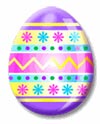Easter Eggs
Jajka wielkanocne to specjalnie udekorowane jajka rozdawane z okazji święta wielkanocnego. Najstarszą tradycją jest używanie barwionych i malowanych jaj kurzych, ale współczesnym zwyczajem jest zastępowanie jaj z czekolady lub plastikowych jajek wypełnionych cukierkami, np. galaretką.
 Easter eggs are specially decorated eggs given out to celebrate the Easter holiday. The oldest tradition is to use dyed and painted chicken eggs, but a modern custom is to substitute eggs made from chocolate, or plastic eggs filled with candy such as jellybeans.
Easter eggs are specially decorated eggs given out to celebrate the Easter holiday. The oldest tradition is to use dyed and painted chicken eggs, but a modern custom is to substitute eggs made from chocolate, or plastic eggs filled with candy such as jellybeans.
Candy Easter eggs can be any form of confectionery such as hollow chocolate eggs wrapped in brightly-colored foil. Some are delicately constructed of spun sugar and pastry decoration techniques. The ubiquitous jelly egg or jellybean is made from sugar-coated pectin candy. These are often hidden, supposedly by the Easter Bunny, for children to find on Easter morning.
Decorated eggs are much older than Easter, and both eggs and rabbits are age-old fertility symbols. The Passover Seder service uses a hard-cooked egg flavored with salt water as a symbol both of new life and the Temple service in Jerusalem. The Jewish tradition may have come from earlier Roman Spring feasts.
Easter egg origin stories abound - one has an emperor claiming that the Resurrection was as likely as eggs turning red; more prosaically the Easter egg tradition may have celebrated the end of the privations of Lent. In the West, eggs were seen as "meat", which would have been forbidden during Lent. Likewise, in Eastern Christianity, both meat and dairy were prohibited during the fast, and eggs were seen as "dairy" (a foodstuff that could be taken from an animal without shedding its blood). One would have been forced to hard boil the eggs that the chickens produced so as not to waste food, and for this reason the Spanish dish hornazo (traditionally eaten on and around Easter) contains hard-boiled eggs as a primary ingredient.
Easter eggs are a widely popular symbol of new life in Poland and other Slavic countries' folk traditions. A batik-like decorating process known as pisanka produces intricate, brilliantly-colored eggs. The celebrated Fabergé workshops created exquisite jewelled Easter eggs for the Russian Imperial Court. A 27-foot (9 m) sculpture of a pisanka stands in Vegreville, Alberta.
There are many other decoration techniques and numerous traditions of giving them as a token of friendship, love or good wishes. A tradition exists in some parts of Britain (such as Scotland) of rolling painted eggs down steep hills on Easter Sunday. In the U.S., such an Easter egg roll (unrelated to an eggroll) is often done on flat ground, pushed along with a spoon. The most well-known egg roll is done at the White House. An Easter egg hunt is a common festive activity, where eggs are hidden outdoors (or indoors if in bad weather) for children to run around and find. This may also be a contest to see who can collect the most eggs.
When boiling hard-cooked eggs for Easter, a nice tan colour can be achieved by boiling the eggs with onion skin.
Deep-fried chocolate Easter eggs are sold around Easter time in Scottish fish and chips shops. The idea was invented in a northeastern Scottish takeaway as a sequel to the extremely popular deep-fried Mars Bar.
***
celebrate - świętować
- dyed - ufarbowany
- substitute - substytut, zastępczy
- jellybeans - żelki
- confectionery - słodycze, ciastka
- hollow - wydrążony
- wrapped - opakowany, zawinięty
- pastry - ciasto
- fertility - płodność, żyzność
- Passover - Pascha
- the ResurrectionZmartwychwstanie
- privation - niedostatek, ubóstwo
- dairy - nabiał
- ingredient składnik
- intricate - zawiły, skmplikowany
- contest - konkurs
